You can make a frog habitat by creating a pond, letting your grass grow tall, or simply burying a plant pot in the soil.
What is a Frog Habitat?
A frog or toad habitat is an environment you create to help these amphibians to thrive. This means providing them with what they need to survive, such as food and shelter, as well as potentially opportunities to breed. There are many different ways you can provide these things for your amphibian friends, and what you offer can be tailored to the space you have available.
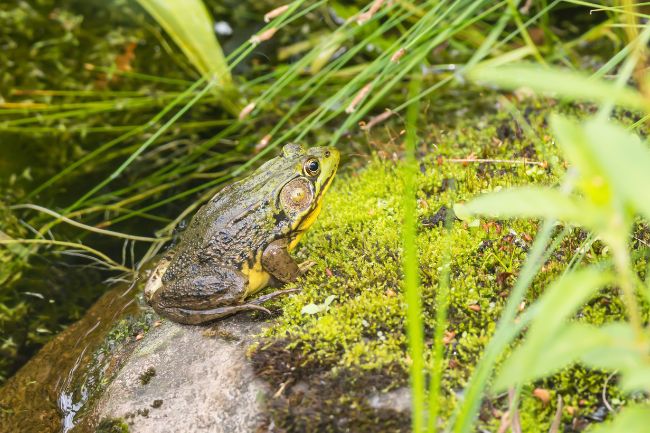
Importance of Creating a Frog Habitat in the Garden
There are over 7,000 species of frogs across the globe, and unfortunately around a third are believed to be at risk of extinction. This is in part because frogs are very sensitive to changes in their environment, such as the presence of pollution or changes in the climate.
By creating a frog habitat this can help to boost populations, by giving frogs a safe environment with plenty of food. Although not all frog species will use these types of habitats, it can also boost insect populations, which can provide food for frogs in the surrounding natural environment.
What do Frogs Need
Frogs and toads are amphibians, meaning they are heavily reliant on water, and can easily become dehydrated. In order to be comfortable in an environment most species need access to damp spaces or water bodies. This could be in the form of a pond, or a cool, dark location such as a burrow or under a logpile.
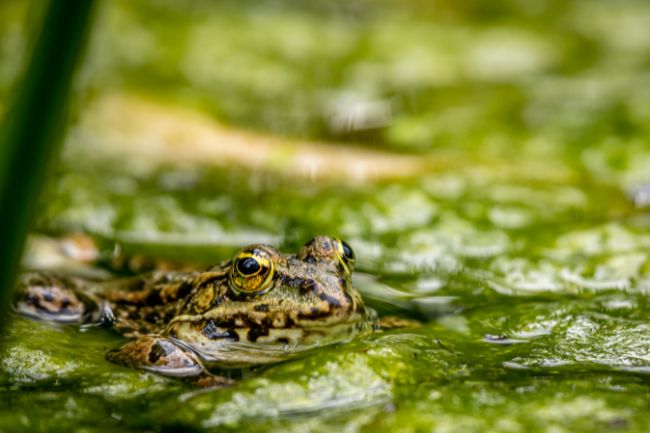
Alongside somewhere to keep damp, frogs benefit from somewhere to shelter. This could be a gap in a wall, a space under a shed, or within leaf litter. Such safe spaces, can allow frogs to escape from predators, and to have a place to hibernate during cold winter months, when they are less active.
As well as housing, frogs need plenty to eat. Frogs are carnivores, with different species specializing in eating different things, however, the vast majority are insectivores, eating a wide range of species, such as flies, spiders and slugs. In order to ensure there are lots of insects around it’s important to provide what those insects need to survive, namely food and shelter.
Also read: Frogs in a Pond: What Do They Eat?
Natural Habitats of Frogs
Within the natural environment, frogs can live across many different kinds of habitats, such as rainforests, meadows, or even desert. Different species have adapted to very different lifestyles, some having learnt to live in trees, while others are aquatic, living all their time below the water.
Non-aquatic species are often still associated with water, living near ponds, rivers or lakes, however they will often use these water bodies mostly during mating season, and spend much of the rest of their time within other habitats such of grasslands, where they can find plenty of prey.
Types of Frogs That Can be Attracted to a Garden Habitat
What species of frog are attracted to a garden depends largely on where the garden is located. Many species of frog will utilize habitats that can be a part of a garden, such as grasslands, scrubs and ponds.
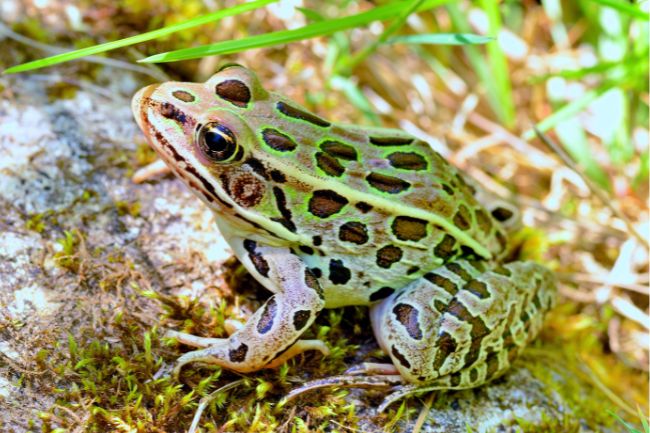
- Common frog: Within the UK common frogs are the most likely species to appear in a garden. Common frogs can vary in appearance, but are mostly a mottled green or brown in appearance.
- Leopard frog: Leopard frogs are a distinctive looking species, with dark leopard-like spots on a green body. Leopard frogs are found from Canada down to central America.
- Gray tree frog: As the name suggests gray tree frogs are an arboreal species, whose skin is well camouflaged against the foliage.
Choosing the Right Location
When it comes to where to locate your frog habitat, there are a number of things to be considered.
In a Cool Humid Location
It’s important that frogs using the habitat don’t overheat. Locating the habitat in a shady location will prevent it overheating, and make sure that humidity remains high. High humidity and lower temperatures will prevent the frog from becoming dehydrated on hot days.
Connected to Other Habitats
Most frog species cannot fly, or climb particularly high, with the exception of arboreal species. This means that frogs will enter the habitat on foot, so to speak. If barriers are in the way then frogs may not be able to reach the habitat. Additionally, connecting habitats together, will allow frogs to travel safely with less risk of being predated.
Also read: Here’s “How Frogs Find Ponds”
Away From Pets
Many pets are very curious of small animals such as frogs. While some may simply observe frogs, others will attack them, or attempt to eat them. Cats in particular can harm frogs, therefore it can be good to have frog habitats away from where dogs and cats might spend time.
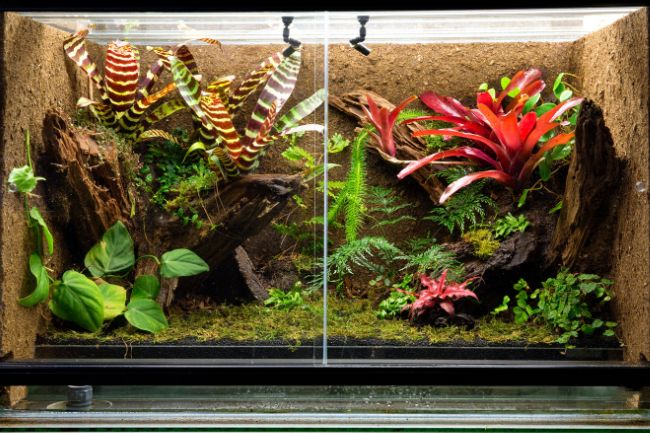
Size of the Habitat
The good thing about frogs is that, because of their size, they can benefit from a relatively small area. Of course larger areas will provide food and homes for a larger population.
Creating the Habitat
Shelter
Providing shelter for frogs can come in a variety of different forms. Shelters must be composed of a non-toxic material that creates some kind of hollow in which the frog can sit. A common household item that could be used to create a shelter is a flowerpot, which can be partly buried in the ground.
Other more natural materials that can be used include wood and stones, to create piles with hollows in the middle. Any structure created should be out of direct sunlight, and stable enough that it won’t move over time.
As well as making shelters specialised frog shelters can also be purchased, which will provide the same kind of home for your frogs.
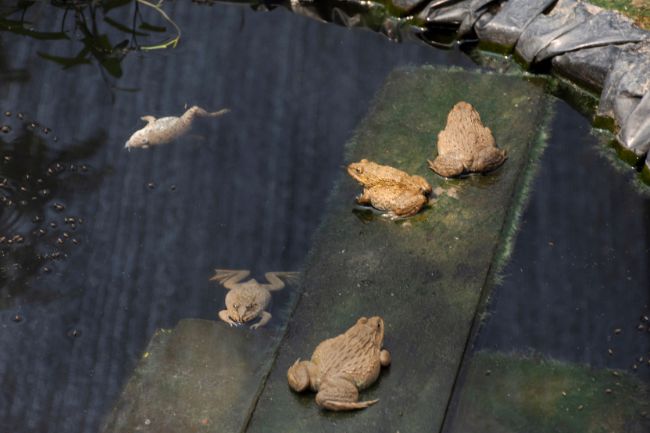
Food
Providing food for frogs means providing food and shelter for a wide variety of other wildlife, in particular insect species. Planting native plants within the garden, as well as shrubs and potentially trees, is a great way to encourage lots of insects.
In order to ensure insects are able to complete their full lifecycle it’s important not to tidy up the garden too much during the winter. Many insects spend their winter amongst leaf litter, hibernating in hollow twigs, or underneath bark.
Water can be a great thing to provide both for frogs and insects. If you don’t want to create a larger pond, simply using a small dish like a bird bath can provide water to wildlife. Frogs may choose to sit in this bath to rehydrate, but it can also provide water for insects, particularly if you place small stones in the water for the insects to land on.
Mating Opportunities
As well as food and shelter, providing mating opportunities for frogs can significantly increase the local population. Most frog species require waterbodies to lay their eggs. Ideally, this waterbody will have natural vegetation, shallow sides and few predators such as fish.
While a natural pond is the best option for frogs to spawn in, even small containers such as old sinks can be suitable, as long as they are accessible.
Also read: Frog Reproduction and Their Life Cycle
Maintaining the Habitat
How to maintain your frog habitat depends on what you’ve decided to create. The good news is that there are many frog habitats that don’t require any maintenance. Leaving a pile of logs or stones for your frog to make into a home, doesn’t need any follow up work. Leaf litter too can just be left, but they will also rot down in time, and should be added to.
Habitats such as ponds can also often be left, however, ponds do eventually fill in with sediment, and will need cleaning out. With most ponds this will take many years, and it’s important not to clean them out too often as frogs benefit from lots of aquatic vegetation and marginal plants.

When it comes to water quality in your pond the key thing is to encourage lots of aquatic plants, and make sure the water feeding into the pond is clean. This means it can’t carry too much silt or run off from areas where fertilisers or chemicals are being used. These would encourage the growth of algaes, which could cause the pond to stagnate.
Grasslands can be managed in a number of ways. Meadows, to encourage wildflowers, should be cut once or twice a year, in April and later in the summer from late July to September. However, tussocky grassland can also benefit frogs, providing places for them to shelter, and food. This type of grassland can be cut less often, every few years.
Brought frog houses, or those created from flowerpots, generally need little maintenance. It doesn’t matter if some vegetation or soil collects within them, as long as there is still space for frogs and toads to get in. If ceramic houses break however, it’s important to dispose of them, as the sharp edges might cause an injury.
Conclusion
Creating frog habitats can be a fun and engaging thing for anyone to do. Depending on the space you have available you can do something small, such as providing a bird bath for frogs to sit in, or something big such as digging a new pond.
By offering your friendly neighbourhood amphibians food, shelter and mating opportunities, you can ensure there will be more of these little creatures around in the future. And while you’re boosting the frog population you’re also helping out insects, birds and mammals, by offering them somewhere to live and thrive.
And of course, there are benefits to us humans too. Getting to watch nature on a regular basis has been shown to be good for our mental and physical health, decreasing stress and allowing us to unwind. So why not enjoy some time listening to the frogs call, and watch the caterpillars munching. Because what’s good for nature, is ultimately good for us.

